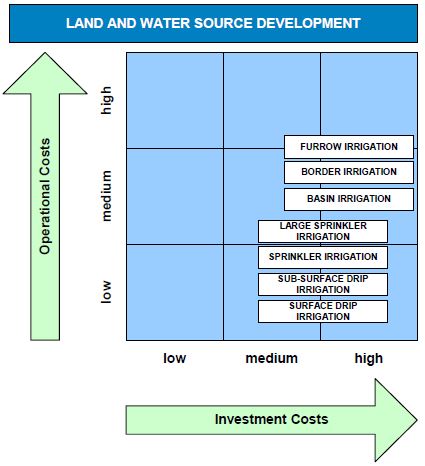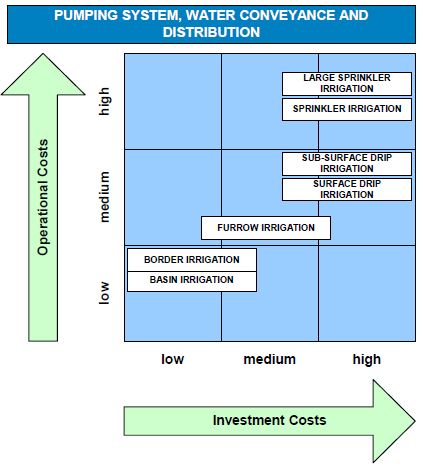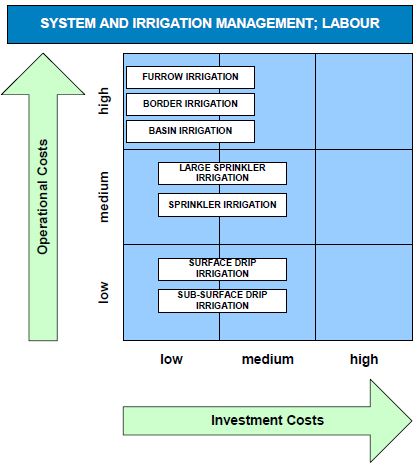Knowledge fuels change
For over a decade, Energypedia has shared free, reliable energy expertise with the world.
We’re now facing a serious funding gap.
Help keep this platform alive — your donation, big or small, truly matters!
Thank you for your support
Comparative Financial Analysis of Irrigation Solutions
Generic Costs of Irrigation Solutions
Costs and financial implications of different irrigation solutions available at any given location around the world vary according to the specific system design and the local prices for the system components. Furthermore, impacts of the different irrigation solutions on farm management vary accordingly.
The cost of a specific irrigation solution is an aggregate of a number of factors that need to be assessed financially:
Table 1: Main cost factors and cost components to be considered for irrigation systems
| Cost factor |
Cost component |
|---|---|
|
Land development/ earthworks, grading |
|
|
Water source/ headworks, well |
|
|
Pumping system | |
|
Water conveyance system/ canal, pipeline | |
|
Water distribution system | |
|
System and irrigation management |
|
|
Labour |
|
These factors cannot be compared on a globalised way, but the impact of different irrigation solutions on these factors can be generalized as illustrated in the figures below:
Surface irrigation approaches require a high degree of land development, but they usually work with simple water abstraction installations such as derivation weirs or river side intakes. Pressurized systems require often a bore well or a deep dug well implying higher initial investment costs. In turn, sprinkler and drip irrigation do not require sophisticated land development (Figure 1).
As for the pumping system, water conveyance and water distribution (Figure 2), pressurized systems require a heavier investment and induce moderate to high operational expenses due to the energy consumption for pumping. Sprinkler irrigation implies high operational expenditure as the systems operate on higher pressure rates as compared to drip irrigation and require regular replacement of mechanical sprinkler equipment. Surface irrigation methods do not induce high operational expenditure as water flow is usually by gravity and secondary level distribution is done manually.
The actual cost of operation of pressurized irrigation systems is low due to the automation. In particular micro-irrigation systems can be operated with minimum of personnel. Sprinkler irrigation systems require a higher degree of labor input due to the need to move the sprinkler units. Surface irrigation methods are laborintensive due to the manual water management on field level (Figure 3).
The consideration of all relevant factors and components of capital and operational expenditure will always result in a specific value for the cost of water in a given system, which is one of the key parameters when comparing irrigation development options, Traditionally, such a comparison was mostly made based on the cost per cubic meter (m3) irrigation water. However, when comparing gravity flow and lift irrigation systems the specific pump head would have to be considered. It is hence useful to calculate the cost per m3 x head (m) = m4.
Financing Impact on Farm Budgets
Irrigation water is an important production factor in agriculture and a market oriented agricultural production without irrigation is not possible in many parts of the world. The extent to which farm households depend on irrigation for their production depends on their geographical or rather agro-climatic location, local hydrological and soil conditions and on the actual crop water requirements.
The actual irrigation method or rather the capital and operational costs related to the specific irrigation method has an impact on three parameters via a number of factors:
- Capital costs and related financing service charges;
- Operational costs;
- Labor costs.
These costs impact the farm budget on several levels. Capital costs and financing service charges for investments (land development, irrigation infrastructure, and irrigation equipment) are often budgeted on an aggregate level, not specifically allotted to individual crop margins as they constitute fixed costs of the farm enterprise.
In practical terms, it would be more pertinent to calculate dynamic costs of the unit irrigation water including capital costs and related financing services in order to have a clear allocation of these costs to the actual crop margin calculation. This can only work, however, if the annual quantities of irrigation water utilized by a farm enterprise do not vary too much.
Operational costs and specific labor requirements are usually taken into account on the level of crop gross margins as they constitute variable costs depending on the actual cultivation.
The share of irrigation water costs within the total production costs of a crop budget varies in dependency from the irrigation method and local cost levels. Simple surface irrigation services could account for as, little as 5 – 10% of the total production charges in subsidized public irrigation schemes. Here, the farmer usually pays a water tax that may be a flat rate or a small volumetric charge. At the other end, in commercially operated pressurized irrigation schemes irrigation charges could account for up to 60% of the actual production costs of a crop. Common percentages are 20 – 30% in surface irrigation systems and 30 – 40% in pressurized irrigation systems.
The level of charges obviously determines the choice of crops and their rotation to a very large extent the higher the variable charges, the higher the need for an increased productivity.
Financial Service Requirements
Capital employed in a farm enterprise is seldom available from the equity of the farm owner or household, in particular when considering small and medium sizeenterprises. Large holdings, which are often producing in an industrialized way, may be considered to be an exception in this regard.
Due to the high interest rates and the short repayment periods loans often constitute a severe problem for the cash flow of a farm household, in particular in years with moderate and sub-average yields and negative market price dynamics.
The very high investment costs related to modern pressurized irrigation systems are usually outside the financing capacity of small and medium size farms as the underlying capital requirement outpaces the annual earnings of these households by large. These households always depend on subsidies and/or financing services to be able to shoulder the investment.
References
Further Information
- Irrigation on Powering Agriculture Portal
- Manual and Tools to promote Solar Powers Irrigation Systems
- Powering Agriculture Portal on energypedia
More details on the irrigation types mentioned in figure 1–3:






















